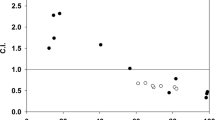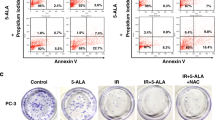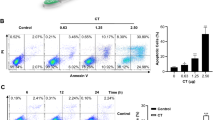Abstract
The rat prostate tumour cell line R3327 AT-1 was transfected with a gene coding for a fusion protein comprised of cytosine deaminase (CD from E. coli) and thymidine kinase (TK from Herpes simplex virus, HSV-1). The resulting AT-1/CDglyTK cell line was sensitive to the prodrug 5-fluorocytosine (IC50 = 78 μM, 96-h incubation) via CD and to ganciclovir (GCV, IC50 = 1 μM, 96 h) via TK. Subcutaneous tumours generated from 100% CDglyTK+ cells responded well to 5-FC therapy (500 mg/kg, i.p., 14 daily treatments, four out of seven animals in remission) and to GCV therapy (30 mg/kg, i.p., 14 daily treatments, five of six animals in remission). However, experiments with mixtures of CDglyTK+ and CDglyTK– cells showed low levels of connexins (intercellular gap junctions) and no bystander effect for nontransfected cells using either 5-FC or GCV therapy. Furthermore, 19F-NMR spectroscopy showed that incubation of cultured CDglyTK+ cells with 774 μM 5-FC for 16 h resulted in the following intracellular concentrations: 5-FC = 314 μM, 5-FU = 52 μM, cytotoxic fluoronucleotides = 163 μM; extracellular 5-FU reached only 6.4 μM. Thus, in this model system intracellular trapping of 5-FU (slow export) contributes to the failure of the CD/5-FC bystander effect via an extracellular route.
This is a preview of subscription content, access via your institution
Access options
Subscribe to this journal
Receive 12 print issues and online access
$259.00 per year
only $21.58 per issue
Buy this article
- Purchase on Springer Link
- Instant access to full article PDF
Prices may be subject to local taxes which are calculated during checkout








Similar content being viewed by others
References
Moolten FL . Drug sensitivity (‘suicide’) genes for selective cancer chemotherapy Cancer Gene Ther 1994 1: 279–287
Morris JC et al. Suicide genes: gene therapy applications using enzyme/prodrug strategies Friedmann T (eds); The Development of Human Gene Therapy Cold Spring Harbor Laboratory Press 1999 pp 477–526
Heidelberger C, Danenberg PV, Moran RG . Fluorinated pyrimidines and their nucleosides Adv Enzymol 1983 54: 57–119
Calabresi P, Chabner BA . Chemotherapy of neoplastic diseases Hardman JG (eds); Goodman & Gilman's ‘The Pharmacological Basis of Therapeutics’ McGraw-Hill 1995 pp 1225–1287
Weckbecker G . Biochemical pharmacology and analysis of fluoropyrimidines alone and in combination with modulators Pharmacol Ther 1991 50: 367–424
Mullen CA . Cytosine deaminase as a suicide gene in cancer gene therapy Lattime EC, Gerson SL (eds); Gene Therapy of Cancer Academic Press 1999 pp 201–208
Huber BE et al. In vivo antitumor activity of 5-fluorocytosine on human colorectal carcinoma cells genetically modified to express cytosine deaminase Cancer Res 1993 53: 4619–4626
Trinh QT et al. Enzyme/prodrug gene therapy: comparison of cytosine deaminase/5-fluorocytosine versus thymidine kinase/ganciclovir enyzme/prodrug systems in a human colorectal carcinoma cell line Cancer Res 1995 55: 4808–4812
Kuriyama S et al. Bacterial cytosine deaminase suicide gene transduction renders hepatocellular carcinoma sensitive to the prodrug 5-fluorocytosine Int Hepatol Commun 1995 4: 72–79
Hirschowitz EA et al. In vivo adenovirus-mediated gene transfer of the Escherichia coli cytosine deaminase gene to human colon carcinoma-derived tumours induces chemosensitivity to 5-fluorocytosine Hum Gene Ther 1995 6: 1055–1063
Dong Y et al. In vivo replication-deficient adenovirus vector-mediated transduction of the cytosine deaminase gene sensitizes glioma cells to 5-fluorocytosine Hum Gene Ther 1996 7: 713–720
Yin L et al. Sensitization of prostate cancer cell lines to 5-fluorocytosine induced by adenoviral vector carrying a CD transcription unit Chin Med J 2001 114: 972–975
Miller CR, Williams CR, Buchsbaum DJ, Gillespie GY . Intratumoral 5-fluorouracil produced by cytosine deaminase/5-fluorocytosine gene therapy is effective for experimental human glioblastomas Cancer Res 2002 62: 773–780
Stegman LD et al. Noninvasive quantitation of cytosine deaminase transgene expression in human tumour xenografts with in vivo magnetic resonance spectroscopy Proc Natl Acad Sci USA 1999 96: 9821–9826
Hamstra DA et al. Enzyme/prodrug therapy for head and neck cancer using a catalytically superior cytosine deaminase Hum Gene Ther 1999 10: 1993–2003
Daher GC, Harris BE, Diasio RB . Metabolism of pyrimidine analogues and their nucleosides Pharmacol Ther 1990 48: 189–222
Kanai F et al. Adenovirus-mediated transduction of Escherichia coli uracil phosphoribosyltransferase gene sensitizes cancer cells to low concentrations of 5-fluorouracil Cancer Res 1998 58: 1446–1451
Adachi Y et al. Experimental gene therapy for brain tumors using adenovirus-mediated transfer of cytosine deaminase gene and uracil phosphoribosyltransferase gene with 5-fluorocytosine Hum Gene Ther 2000 11: 77–89
Kawamura K et al. Bystander effect in uracil phosphoribosyltransferase/5-fluorouracil-mediated suicide gene therapy is correlated with the level of intercellular communication Int J Oncol 2001 18: 117–120
Rogers RP et al. Killing Epstein-Barr virus-positive B lymphocytes by gene therapy: comparing the efficacy of cytosine deaminase and herpes simplex virus thymidine kinase Hum Gene Ther 1996 7: 2235–2245
Vrionis FD et al. The bystander effect exerted by tumor cells expressing the herpes simplex virus thymidine kinase (HSVtk) gene is dependent on connexin expression and cell communication via gap junctions Gene Therapy 1997 4: 577–585
Rosolen A et al. In vitro and in vivo antitumor effects of retrovirus-mediated herpes simplex thymidine kinase gene-transfer in human medulloblastoma Gene Therapy 1998 5: 113–120
Touraine RL, Ishii-Morita H, Ramsey WJ, Blaese RM . The bystander effect in the HSVtk/ganciclovir system and its relationship to gap junctional communication Gene Therapy 1998 5: 1705–1711
Shirakawa T et al. Cytotoxicity of adenoviral-mediated cytosine deaminase plus 5-fluorocytosine gene therapy is superior to thymidine kinase plus acyclovir in a human renal cell carcinoma model J Urol 1999 162: 949–954
Rogulski KR, Kim JH, Kim SH, Freytag SO . Glioma cells transduced with an Escherichia coli CD/HSV-1 TK fusion gene exhibit enhanced metabolic suicide and radiosensitivity Hum Gene Ther 1997 8: 73–85
Rogulski KR et al. Pronounced antitumour effects and tumour radiosensitization of double suicide gene therapy Clin Cancer Res 1997 3: 2081–2088
Freeman SM et al. The ‘bystander effect’: tumour regression when a fraction of the tumour mass is genetically modified Cancer Res 1993 53: 5274–5283
Elshami AA et al. Gap junctions play a role in the ‘bystander effect’ of the herpes simplex virus thymidine kinase/ganciclovir system in vitro Gene Therapy 1996 3: 85–92
Mesnil M et al. Bystander killing of cancer cells by herpes simplex virus thymidine kinase gene is mediated by connexins Proc Natl Acad Sci USA 1996 93: 1831–1835
Wygoda MR et al. Protection of herpes simplex virus thymidine kinase-transduced cells from ganciclovir-mediated cytotoxicity by bystander cells: the Good Samaritan effect Cancer Res 1997 57: 1699–1703
Ishii-Morita H et al. Mechanism of ‘bystander effect’ killing in the herpes simplex thymidine kinase gene therapy model of cancer treatment Gene Therapy 1997 4: 244–251
Huber BE, Richards CA, Krenitsky TA . Metabolism of 5-fluorocytosine to 5-fluorouracil in human colorectal tumour cells transduced with the cytosine deaminase gene: significant antitumour effects when only a small percentage of tumour cells express cytosine deaminase Proc Natl Acad Sci USA 1994 91: 8302–8306
Kuriyama S et al. Bystander effect caused by cytosine deaminase gene and 5-fluorocytosine in vitro is substantially mediated by generated 5-fluorouracil Anticancer Res 1998 18: 3399–3406
Lawrence TS et al. Preferential cytotoxicity of cells transduced with cytosine deaminase compared to bystander cells after treatment with 5-fluorocytosine Cancer Res 1998 58: 2588–2593
Hull WE et al. Metabolites of 5-fluorouracil in plasma and urine, as monitored by 19F nuclear magnetic resonance spectroscopy, for patients receiving chemotherapy with or without methotrexate pretreatment Cancer Res 1988 48: 1680–1688
Naser-Hijazi B et al. Locoregional administration of 5-fluoro-2’-deoxyuridine (FUDR) in Novikoff hepatoma in the rat: effects of dose and infusion time on tumor growth and on FUDR metabolite levels in tumor tissue as determined by 19F-NMR spectroscopy J Cancer Res Clin Oncol 1991 117: 295–304
El-Tahtawy A, Wolf W . In vivo measurements of intratumoural metabolism, modulation, and pharmacokinetics of 5-fluorouracil, using 19F nuclear magnetic resonance spectroscopy Cancer Res 1991 51: 5806–5812
Schlemmer HP et al. Alterations of intratumoural pharmacokinetics of 5-fluorouracil in head and neck carcinoma during simultaneous radiochemotherapy Cancer Res 1999 59: 2363–2369
Lutz NW, Hull WE . Assignment and pH dependence of the 19F-NMR resonances from the fluorouracil anabolites involved in fluoropyrimidine chemotherapy NMR Biomed 1999 12: 237–248
Martino R, Malet-Martino M, Gilard V . Fluorine nuclear magnetic resonance, a privileged tool for metabolic studies of fluoropyrimidine drugs Curr Drug Metab 2000 1: 271–303
Fasoli MOF, Kerridge D, Morris PG, Torosantucci A . 19F nuclear magnetic resonance study of fluoropyrimidine metabolism in strains of Candida glabrata with specific defects in pyrimidine metabolism Antimicrob Agents Chemother 1990 34: 1996–2006
Aboagye EO et al. Intratumoural conversion of 5-fluorocytosine to 5-fluorouracil by monoclonal antibody-cytosine deaminase conjugates: noninvasive detection of prodrug activation by magnetic resonance spectroscopy and spectroscopic imaging Cancer Res 1998 58: 4075–4078
Milano G, Etienne MC . Dihydropyrimidine dehydrogenase (DPD) and clinical pharmacology of 5-fluorouracil (review) Anticancer Res 1994 14: 2295–2298
Beck A et al. A role for dihydropyrimidine dehydrogenase and thymidylate synthase in tumour sensitivity to fluorouracil Eur J Cancer 1994 30A: 1517–1522
Guerquin-Kern JL, Leteurtre F, Croisy A, Lhoste JM . pH dependence of 5-fluorouracil uptake observed by in vivo31P and 19F nuclear magnetic resonance spectroscopy Cancer Res 1991 51: 5770–5773
Wolf W et al. Tumor trapping of 5-fluorouracil: in vivo19F NMR spectroscopic pharmacokinetics in tumor-bearing humans and rabbits Proc Natl Acad Sci USA 1990 87: 492–496
Presant C et al. Association of intratumoral pharmacokinetics of fluorouracil with clinical response Lancet 1994 343: 1184–1187
McSheehy PMJ et al. A pharmacokinetic and pharmacodynamic study in vivo of human HT29 tumours using 19F and 31P magnetic resonance spectroscopy Eur J Cancer 1997 33: 2418–2427
Stubbs M et al. Metabolic consequences of a reversed pH gradient in rat tumors Cancer Res 1994 54: 4011–4016
Gerweck LE . Tumour pH: implications for treatment and novel drug design Semin Radiat Oncol 1998 8: 176–182
Ojugo ASE et al. Influence of pH on the uptake of 5-fluorouracil into isolated tumour cells Br J Cancer 1998 77: 873–879
Dunning WF . Prostatic cancer in the rat Natl Cancer Inst Monogr 1963 12: 351–369
Danielsen S et al. Characterization of the Escherichia coli codBA operon encoding cytosine permease and cytosine deaminase Mol Microbiol 1992 6: 1335–1344
Haack K et al. Detection of cytosine deaminase in genetically modified tumor cells by specific antibodies Hum Gene Ther 1997 8: 1395–1401
Chomczynski P . A reagent for the single-step simultaneous isolation of RNA, DNA and proteins from cell and tissue samples BioTechniques 1993 15: 532–535
Bradford MM . A rapid and sensitive method for the quantitation of microgram quantities of protein utilizing the principle of protein-dye binding Anal Biochem 1976 72: 248–254
Acknowledgements
The authors thank Dr Ivan Zuna (DKFZ) for performing statistical analyses, Gabi Müller (DKFZ) for supplying the AT-1/GFP cell line, Dr JF Gebert (University Clinic, Heidelberg, Germany) for supplying anti-cytosine deaminase antibody, and Dr RP Mason (University of Texas Southwestern Medical Center at Dallas) for the in vivo tumour pH measurements.
Author information
Authors and Affiliations
Rights and permissions
About this article
Cite this article
Corban-Wilhelm, H., Hull, W., Becker, G. et al. Cytosine deaminase and thymidine kinase gene therapy in a Dunning rat prostate tumour model: absence of bystander effects and characterisation of 5-fluorocytosine metabolism with 19F-NMR spectroscopy. Gene Ther 9, 1564–1575 (2002). https://doi.org/10.1038/sj.gt.3301834
Received:
Accepted:
Published:
Issue Date:
DOI: https://doi.org/10.1038/sj.gt.3301834
Keywords
This article is cited by
-
Emerging Implications of Nonmammalian Cytosine Deaminases on Cancer Therapeutics
Applied Biochemistry and Biotechnology (2012)
-
Human neural stem cells target and deliver therapeutic gene to experimental leptomeningeal medulloblastoma
Gene Therapy (2007)
-
Development of a hypoxia-inducible cytosine deaminase expression vector for gene-directed prodrug cancer therapy
Cancer Gene Therapy (2005)
-
A novel fusion suicide gene yeast CDglyTK plays a role in radio-gene therapy of nasopharyngeal carcinoma
Cancer Gene Therapy (2004)
-
Comparison of different methods to assess the cytotoxic effects of cytosine deaminase and thymidine kinase gene therapy
Cancer Gene Therapy (2004)



